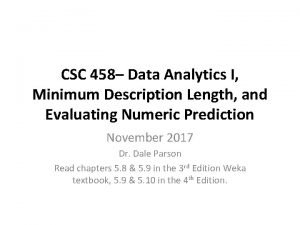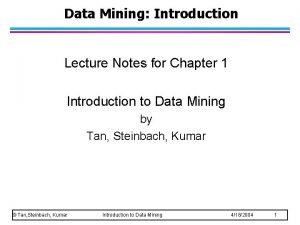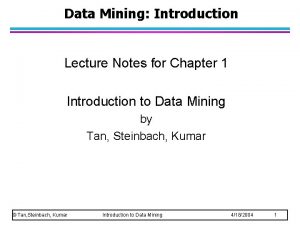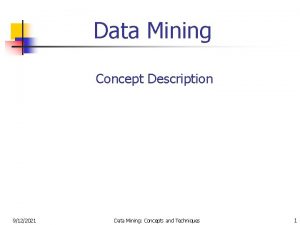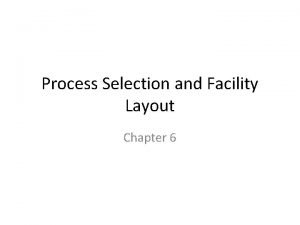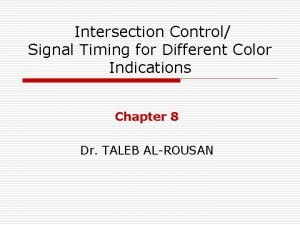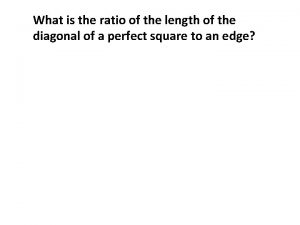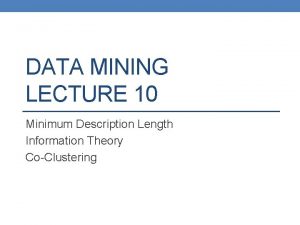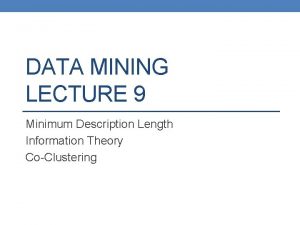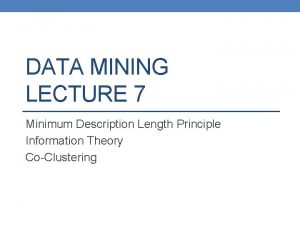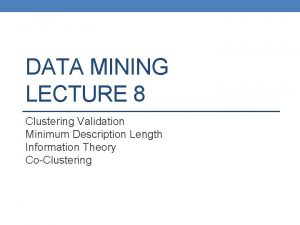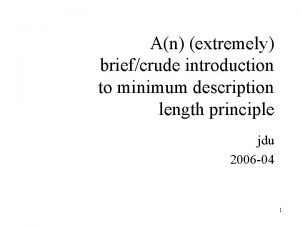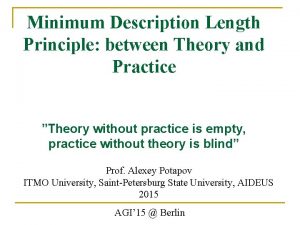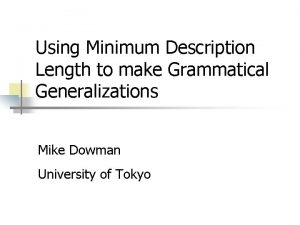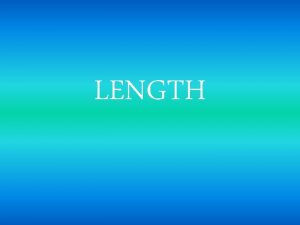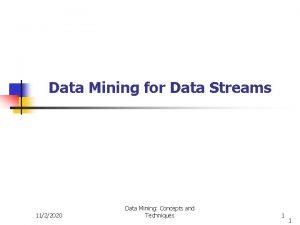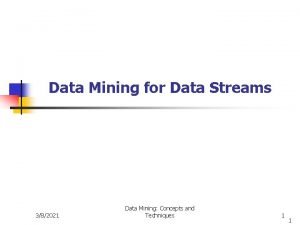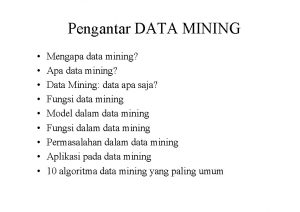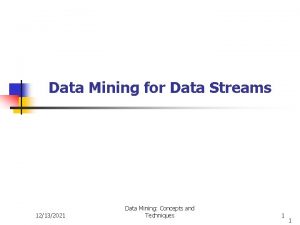DATA MINING LECTURE 9 Minimum Description Length Information






































- Slides: 38

DATA MINING LECTURE 9 Minimum Description Length Information Theory Co-Clustering

MINIMUM DESCRIPTION LENGTH

Occam’s razor • Most data mining tasks can be described as creating a model for the data • E. g. , the EM algorithm models the data as a mixture of Gaussians, the K-means models the data as a set of centroids. • What is the right model? • Occam’s razor: All other things being equal, the simplest model is the best. • A good principle for life as well

Occam's Razor and MDL • What is a simple model? • Minimum Description Length Principle: Every model provides a (lossless) encoding of our data. The model that gives the shortest encoding (best compression) of the data is the best. • Related: Kolmogorov complexity. Find the shortest program that produces the data (uncomputable). • MDL restricts the family of models considered • Encoding cost: cost of party A to transmit to party B the data.

Minimum Description Length (MDL) • The description length consists of two terms • The cost of describing the model (model cost) • The cost of describing the data given the model (data cost). • L(D) = L(M) + L(D|M) • There is a tradeoff between the two costs • Very complex models describe the data in a lot of detail but are expensive to describe the model • Very simple models are cheap to describe but it is expensive to describe the data given the model • This is generic idea for finding the right model • We use MDL as a blanket name.

6 Example • Regression: find a polynomial for describing a set of values • Model complexity (model cost): polynomial coefficients • Goodness of fit (data cost): difference between real value and the polynomial value Minimum model cost High data cost High model cost Minimum data cost MDL avoids overfitting automatically! Source: Grunwald et al. (2005) Tutorial on MDL. Low model cost Low data cost

Example • Suppose you want to describe a set of integer numbers • Cost of describing a single number is proportional to the value of the number x (e. g. , logx). • How can we get an efficient description? • Cluster integers into two clusters and describe the cluster by the centroid and the points by their distance from the centroid • Model cost: cost of the centroids • Data cost: cost of cluster membership and distance from centroid • What are the two extreme cases?

MDL and Data Mining • Why does the shorter encoding make sense? • Shorter encoding implies regularities in the data • Regularities in the data imply patterns • Patterns are interesting • Example 0000100001000010000100010000100001 • Short description length, just repeat 12 times 00001 0100111001010011011010100001110101111011011010101110010011100 • Random sequence, no patterns, no compression

Is everything about compression? • Jürgen Schmidhuber: A theory about creativity, art and fun • Interesting Art corresponds to a novel pattern that we cannot compress well, yet it is not too random so we can learn it • Good Humor corresponds to an input that does not compress well because it is out of place and surprising • Scientific discovery corresponds to a significant compression event • E. g. , a law that can explain all falling apples. • Fun lecture: • Compression Progress: The Algorithmic Principle Behind Curiosity and Creativity

Issues with MDL • What is the right model family? • This determines the kind of solutions that we can have • E. g. , polynomials • Clusterings • What is the encoding cost? • Determines the function that we optimize • Information theory

INFORMATION THEORY A short introduction

Encoding • Consider the following sequence AAABBBAAACCCABACAABBAACCABAC • Suppose you wanted to encode it in binary form, how would you do it? 50% A 25% B 25% C A is 50% of the sequence We should give it a shorter representation This is actually provably the best encoding! A 0 B 10 C 11

Encoding • A 0 B 10 C 11 Uniquely directly decodable For every code we can find a prefix code of equal length

Entropy •

Entropy •

Claude Shannon Father of Information Theory Envisioned the idea of communication of information with 0/1 bits Introduced the word “bit” The word entropy was suggested by Von Neumann • Similarity to physics, but also • “nobody really knows what entropy really is, so in any conversation you will have an advantage”

Some information theoretic measures •

Some information theoretic measures •

Some information theoretic measures •

USING MDL FOR CO-CLUSTERING (CROSS-ASSOCIATIONS) Thanks to Spiros Papadimitriou.

Co-clustering • Simultaneous grouping of rows and columns of a matrix into homogeneous groups Students buying books 5 97% Customer groups 5 3% 10 10 54% Customers 15 15 3% 20 20 96% 25 25 5 Products 10 15 20 25 5 10 Product groups 15 20 25 CEOs buying BMWs

Co-clustering • Step 1: How to define a “good” partitioning? Intuition and formalization • Step 2: How to find it?

Co-clustering Intuition versus Row groups Why is this better? Column groups Good Clustering 1. Similar nodes are grouped together 2. As few groups as necessary implies A few, homogeneous blocks Good Compression

Co-clustering MDL formalization—Cost objective ℓ = 3 col. groups k = 3 row groups n 1 m 2 m 3 p 1, 1 p 1, 2 p 1, 3 density of ones n 1 m 2 H(p 1, 2) bits for (1, 2) block size n 2 p 2, 1 p 2, 2 p 2, 3 i, j entropy nimj H(pi, j) bits total data cost + model cost n 3 p 3, 1 p 3, 2 + p 3, 3 col-partition description row-partition description n × m matrix + log*k + log*ℓ + transmit #partitions i, j log nimj transmit #ones ei, j

Co-clustering MDL formalization—Cost objective n row groups m col groups one row group one col group high code cost low (block contents) + low description cost (block structure) high

Co-clustering MDL formalization—Cost objective k = 3 row groups ℓ = 3 col groups low code cost (block contents) low + description cost (block structure)

one row group one col group n row groups m col groups total bit cost Co-clustering MDL formalization—Cost objective Cost vs. number of groups ℓ k = 3 row groups ℓ = 3 col groups k

Co-clustering • Step 1: How to define a “good” partitioning? Intuition and formalization • Step 2: How to find it?

Search for solution Overview: assignments w/ fixed number of groups (shuffles) original groups row shuffle column shuffle row shuffle reassign all rows, holding column assignments fixed reassign all columns, No cost improvement: holding row Discard assignments fixed

Search for solution Overview: assignments w/ fixed number of groups (shuffles) Final shuffle result row shuffle column row shuffle No cost improvement: Discard

Search for solution Shuffles • Let p 1, 1 p 1, 2 2, 1 2, 2 p 1, 3 Similarity (“KL-divergences”) of row fragments to blocks of aat rowthe group partitions I-th iteration denote row and col. • Fix p I andp for every row x: Assign to second row-group p 2, 3 • Splice into ℓ parts, one for each column group • Let p j, for j = 1, …, ℓ, be the number of ones in each part p 3, 2 3, 1 3, 3 • Assign row x to pthe row group i¤ I+1(x) such that, for all i = 1, …, k,

Search for solution Overview: number of groups k and ℓ (splits & shuffles) k = 5, ℓ = 5

Search for solution Overview: number of groups k and ℓ (splits & shuffles) k = 1, ℓ = 1 shuffle col. split row shuffle row split k = 5, 6, ℓ = 56 k = 5, ℓ = 5 shuffle row split shuffle col. split No cost improvement: Discard shuffle col. splitrow split k=1, ℓ=2 k=2, ℓ=2 Split: Increase k or ℓ shuffle col. split k=2, ℓ=3 shuffle row split k=3, ℓ=3 Shuffle: Rearrange rows or cols shuffle col. split k=3, ℓ=4 k=4, ℓ=5

Search for solution Overview: number of groups k and ℓ (splits & shuffles) k = 1, ℓ = 1 k = 5, ℓ = 5 Final result k=1, ℓ=2 k=2, ℓ=2 Split: Increase k or ℓ k=2, ℓ=3 k=3, ℓ=3 Shuffle: Rearrange rows or cols k=3, ℓ=4 k=4, ℓ=5

Co-clustering CLASSIC Documents CLASSIC corpus • 3, 893 documents • 4, 303 words • 176, 347 “dots” (edges) Words Combination of 3 sources: • MEDLINE (medical) • CISI (info. retrieval) • CRANFIELD (aerodynamics)

Graph co-clustering Documents CLASSIC Words “CLASSIC” graph of documents & words: k = 15, ℓ = 19

Co-clustering CLASSIC insipidus, alveolar, aortic, death, prognosis, intravenous blood, disease, clinical, cell, tissue, patient paint, examination, fall, raise, leave, based MEDLINE (medical) CISI (Information Retrieval) CRANFIELD (aerodynamics) providing, studying, records, development, students, rules abstract, notation, works, construct, bibliographies “CLASSIC” graph of documents & words: k = 15, ℓ = 19 shape, nasa, leading, assumed, thin

Co-clustering CLASSIC Recall 0. 996 0. 990 0. 97 -0. 99 0. 968 Precision 0. 997 1. 000 0. 984 0. 978 0. 960 1. 000 0. 982 0. 968 1. 000 0. 939 1. 000 0. 999 0. 975 0. 94 -1. 00 Document class cluster # CRANFIELD CISI MEDLINE 1 0 1 390 2 0 0 610 3 2 676 9 4 1 317 6 5 3 452 16 6 207 0 0 7 188 0 0 8 131 0 0 9 209 0 0 10 107 2 0 11 152 3 2 12 74 0 0 13 139 9 0 14 163 0 0 15 24 0 0 0. 987
 Csc458
Csc458 Eck
Eck Multimedia data mining
Multimedia data mining Bayesian classification in data mining lecture notes
Bayesian classification in data mining lecture notes Data mining lecture notes
Data mining lecture notes Data mining lecture notes
Data mining lecture notes Data mining lecture notes
Data mining lecture notes Concept description in data mining
Concept description in data mining Relevance analysis in data mining
Relevance analysis in data mining Local minimum
Local minimum Process choice is driven
Process choice is driven Minimum cycle length
Minimum cycle length Minimum length nozzle
Minimum length nozzle Information gain in data mining
Information gain in data mining Strip mining vs open pit mining
Strip mining vs open pit mining Mineral resources and mining chapter 13
Mineral resources and mining chapter 13 Difference between strip mining and open pit mining
Difference between strip mining and open pit mining Web text mining
Web text mining 01:640:244 lecture notes - lecture 15: plat, idah, farad
01:640:244 lecture notes - lecture 15: plat, idah, farad What is the ratio of the length of to the length of ?
What is the ratio of the length of to the length of ? Data reduction in data mining
Data reduction in data mining Data mining in data warehouse
Data mining in data warehouse What is missing data in data mining
What is missing data in data mining Concept hierarchy generation for nominal data
Concept hierarchy generation for nominal data Data reduction in data mining
Data reduction in data mining Data reduction in data mining
Data reduction in data mining Shell cube in data mining
Shell cube in data mining Data reduction in data mining
Data reduction in data mining Data warehouse dan data mining
Data warehouse dan data mining Perbedaan data warehouse dan data mining
Perbedaan data warehouse dan data mining Olap crm
Olap crm Mining complex types of data
Mining complex types of data Data warehouse and olap technology for data mining
Data warehouse and olap technology for data mining Noisy data in data mining
Noisy data in data mining Explain the three tier architecture of data warehouse
Explain the three tier architecture of data warehouse Data preparation for data mining
Data preparation for data mining Data compression in data mining
Data compression in data mining Introduction to data mining and data warehousing
Introduction to data mining and data warehousing Data warehouse dan data mining
Data warehouse dan data mining
